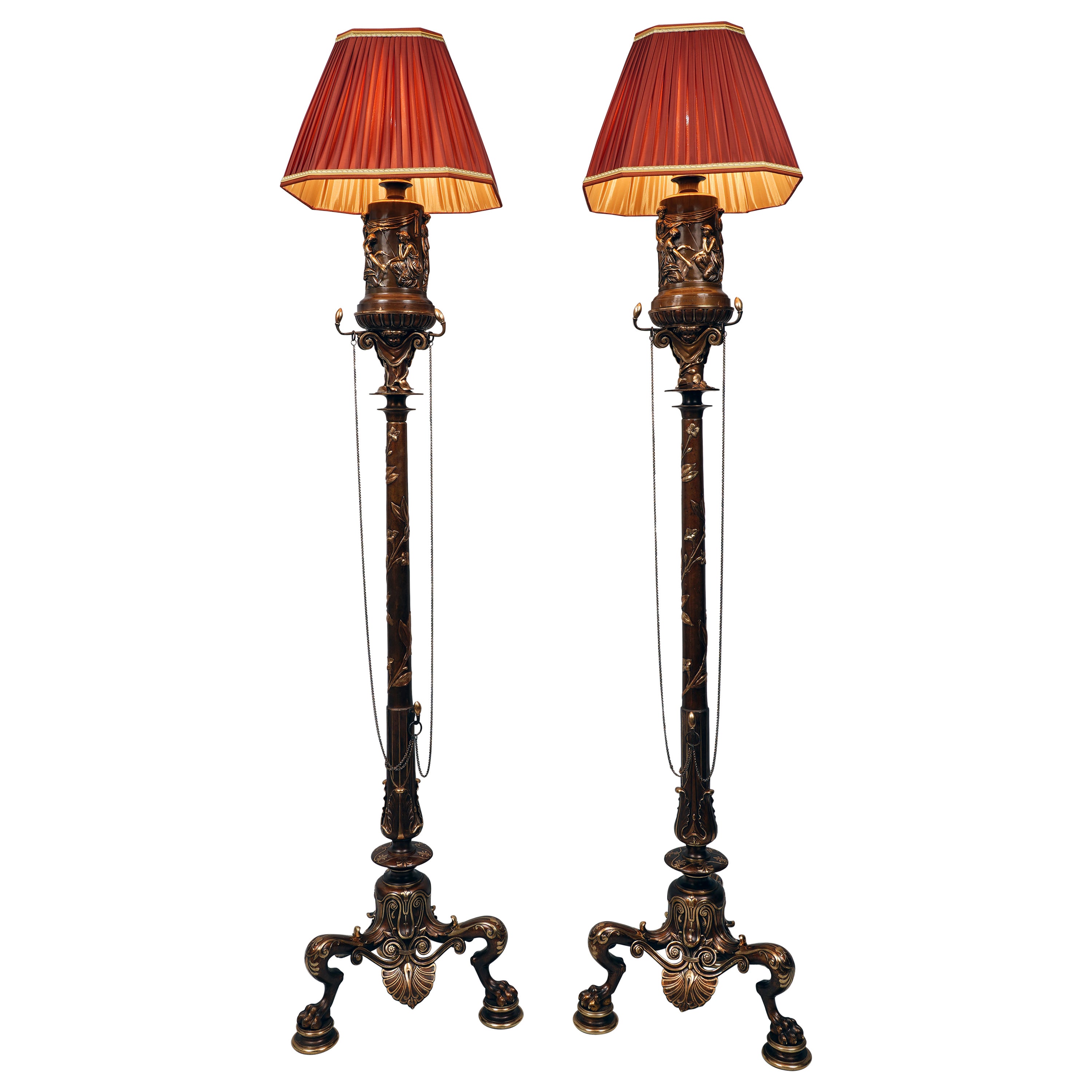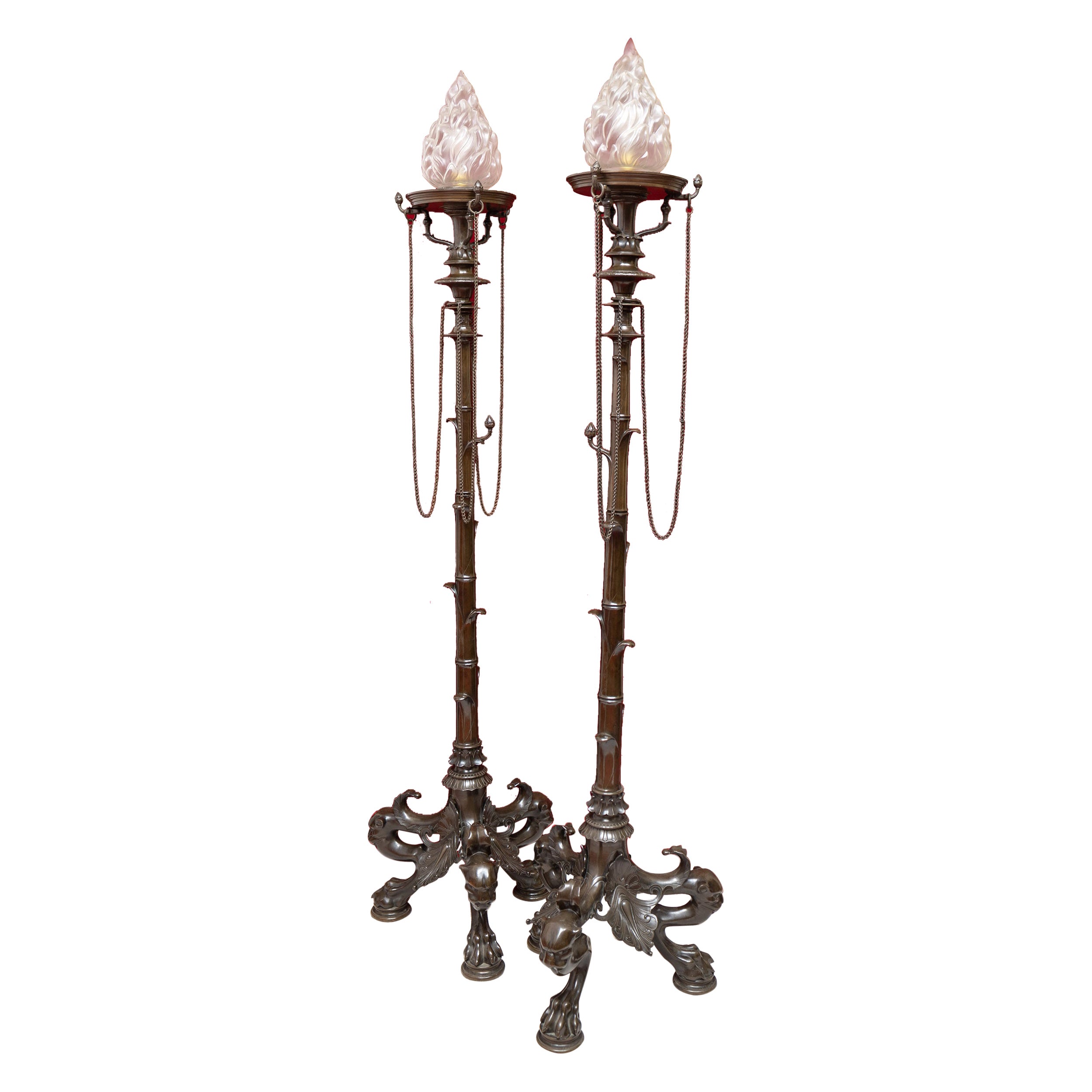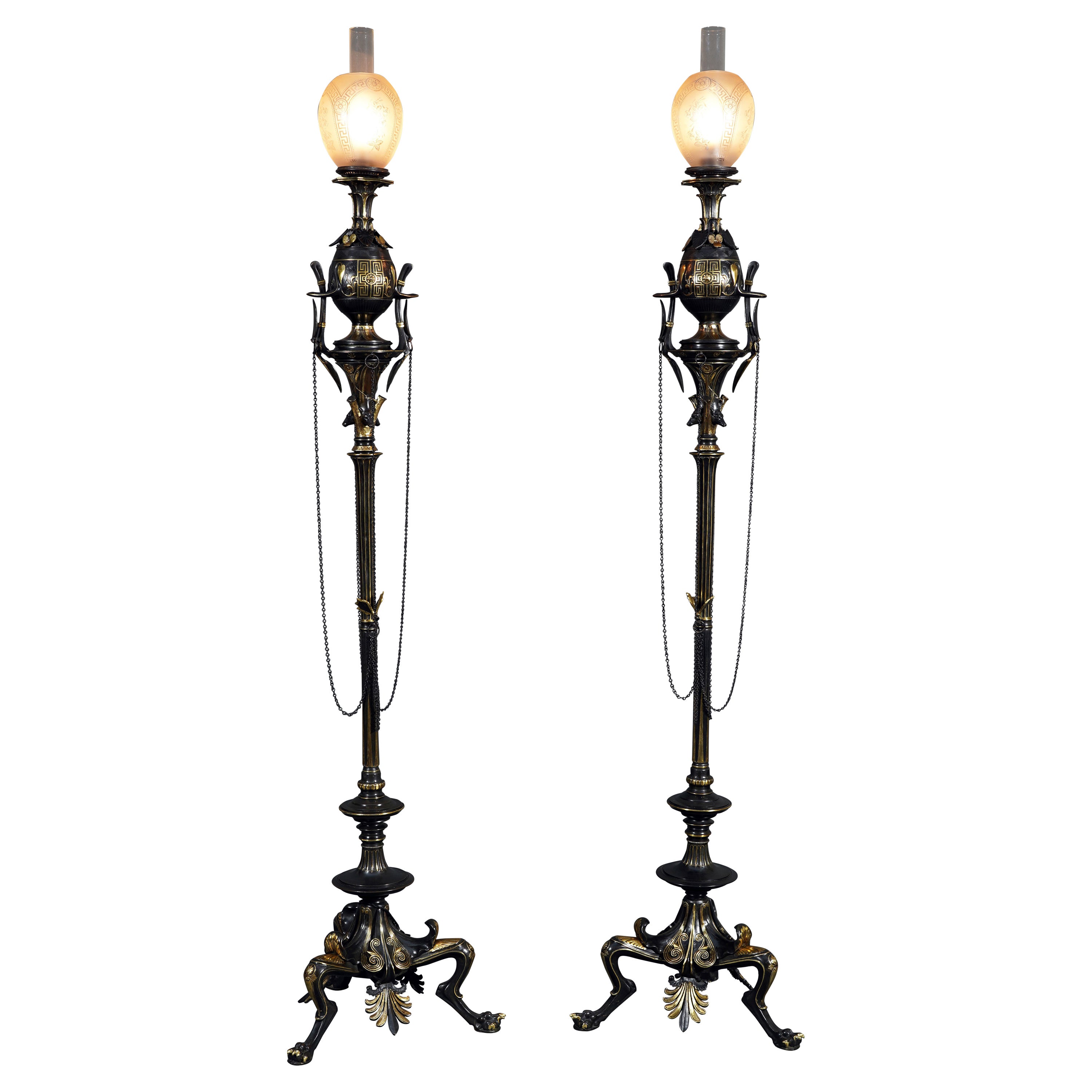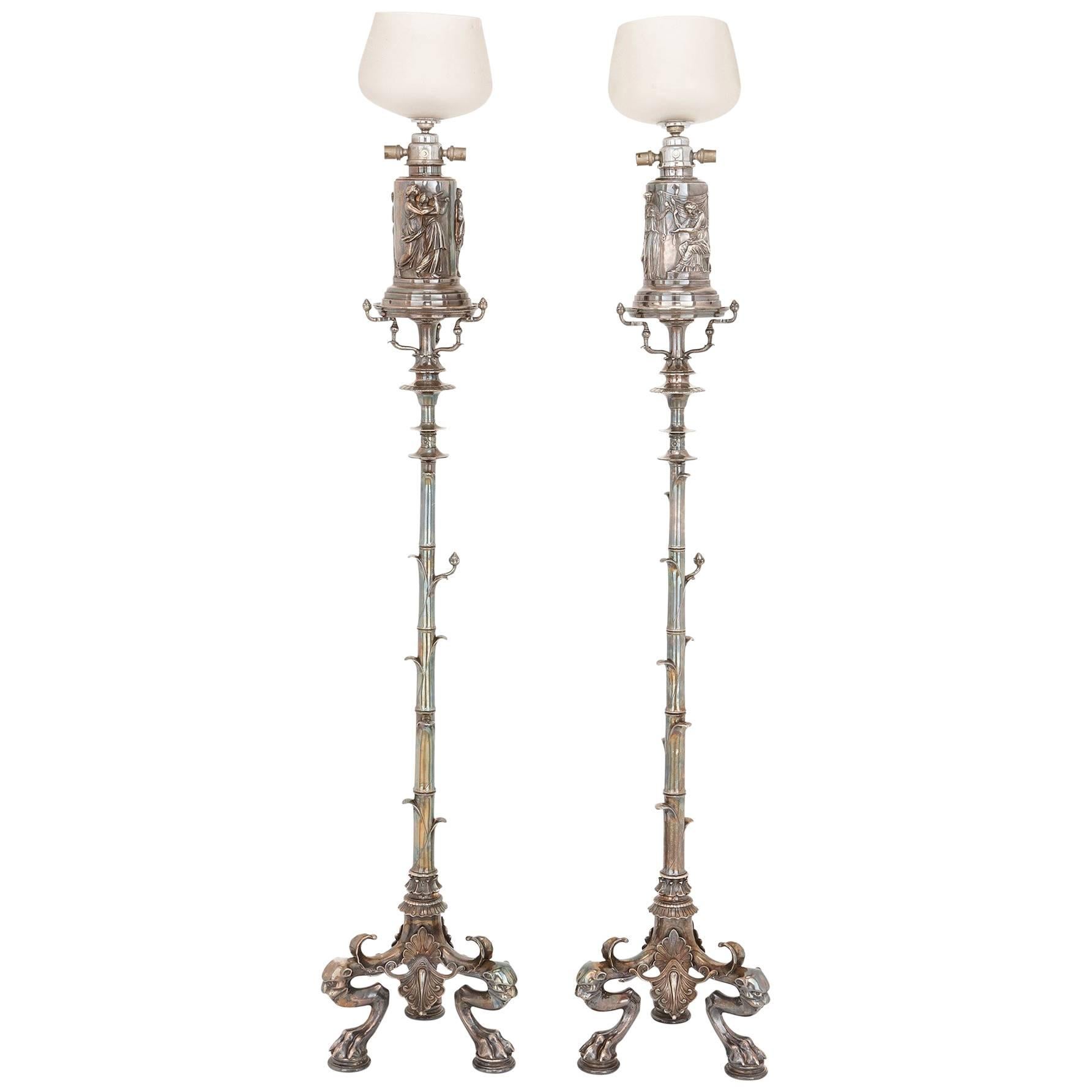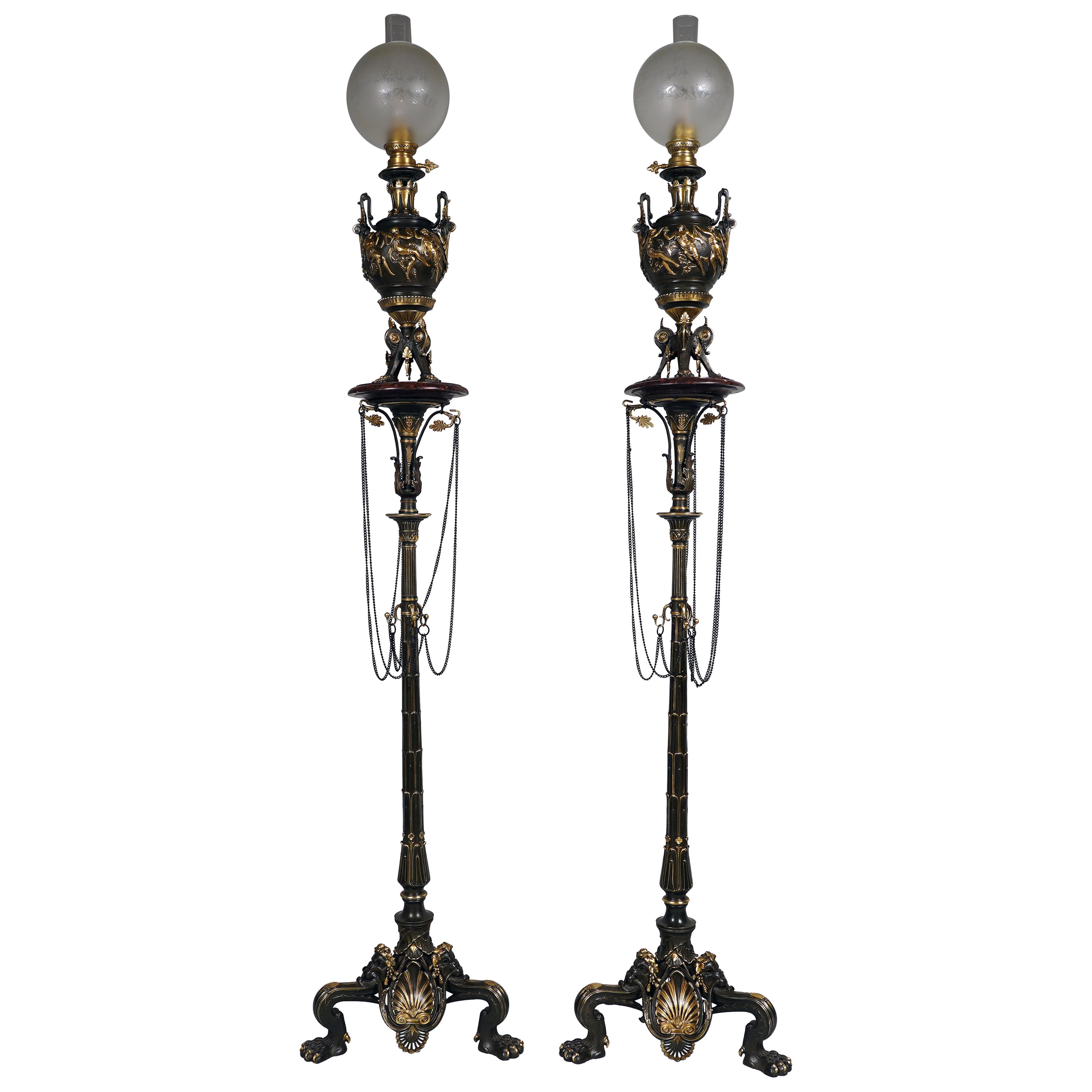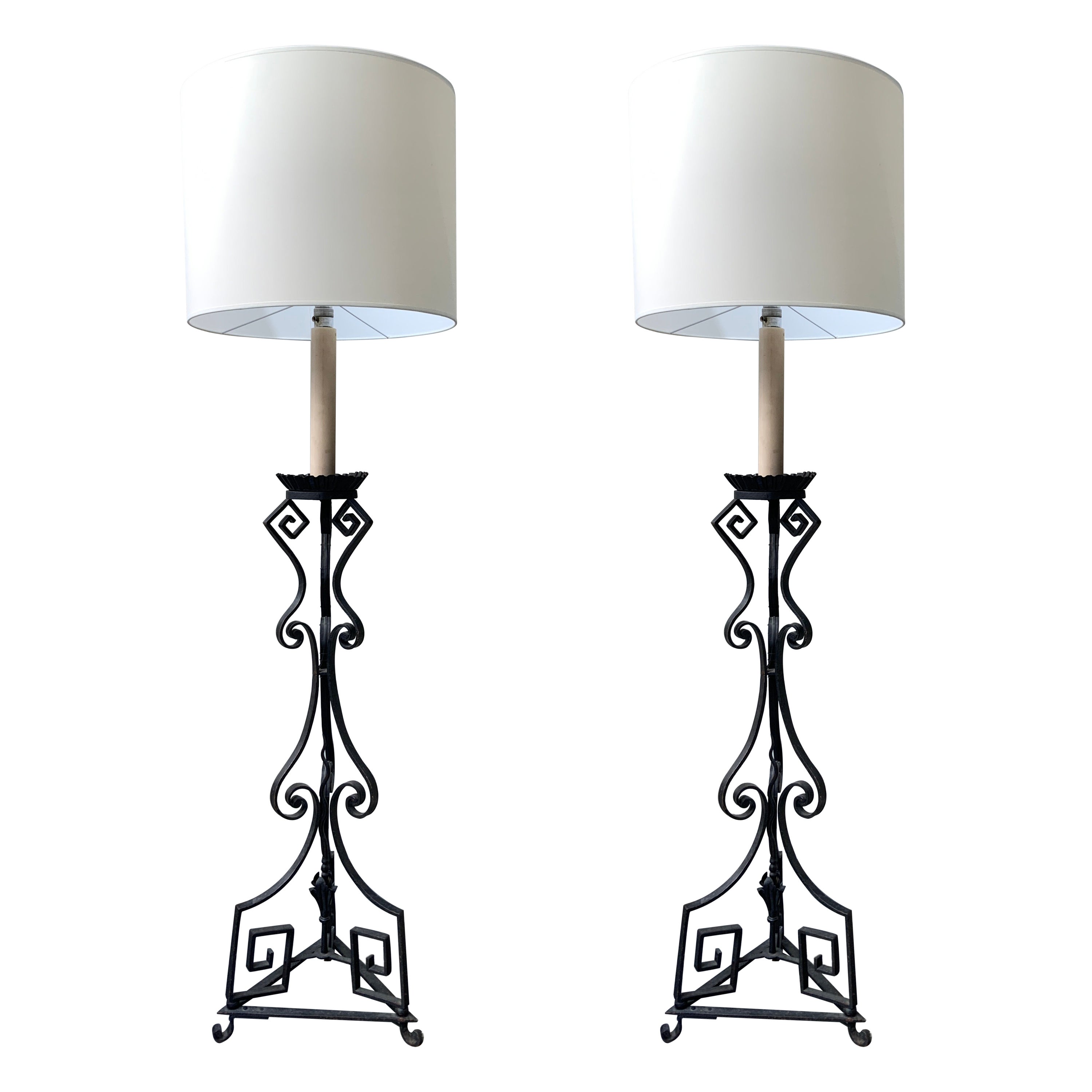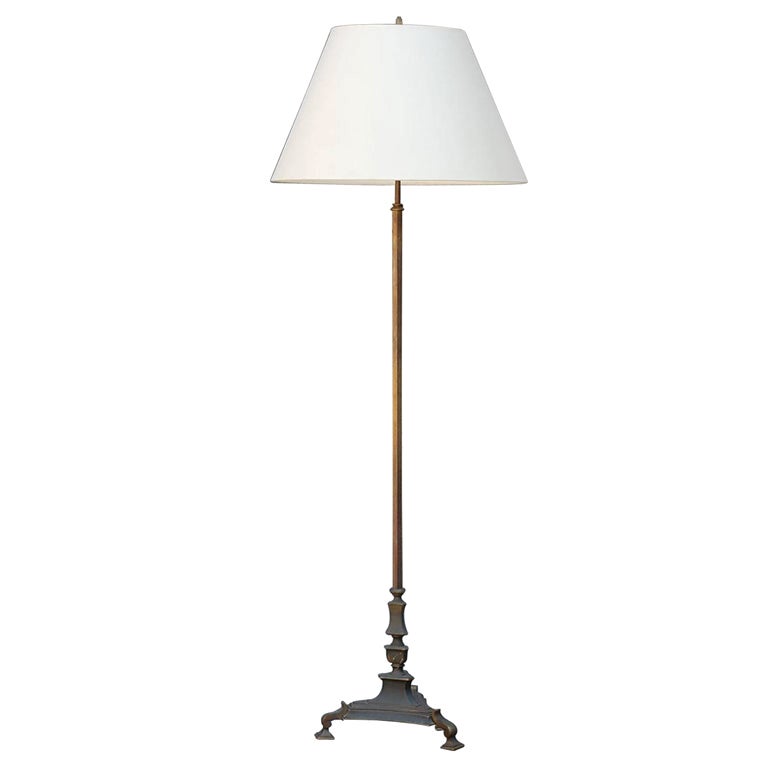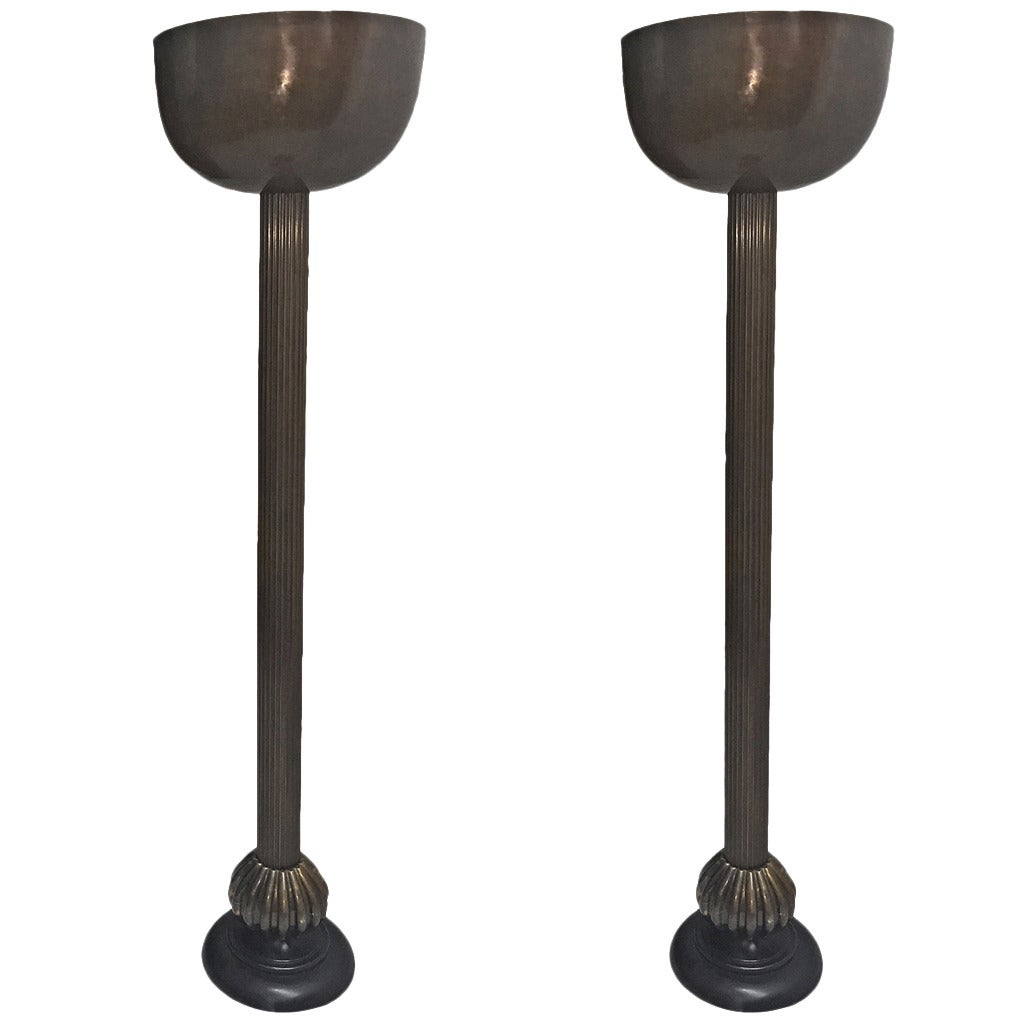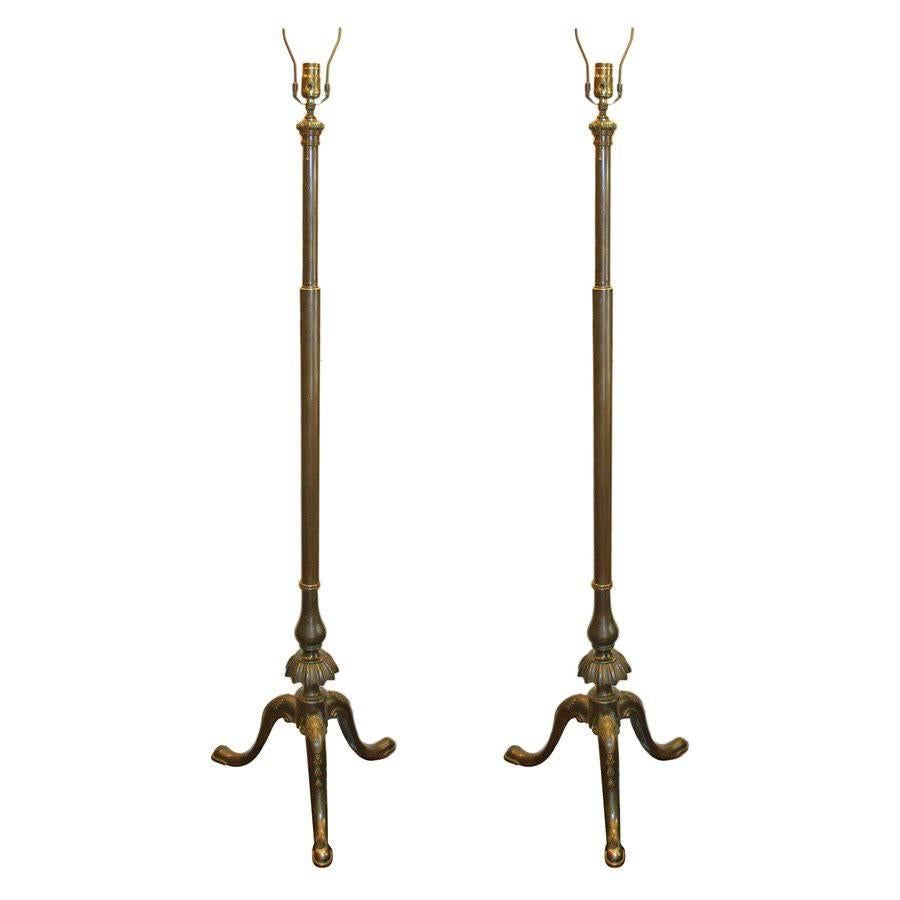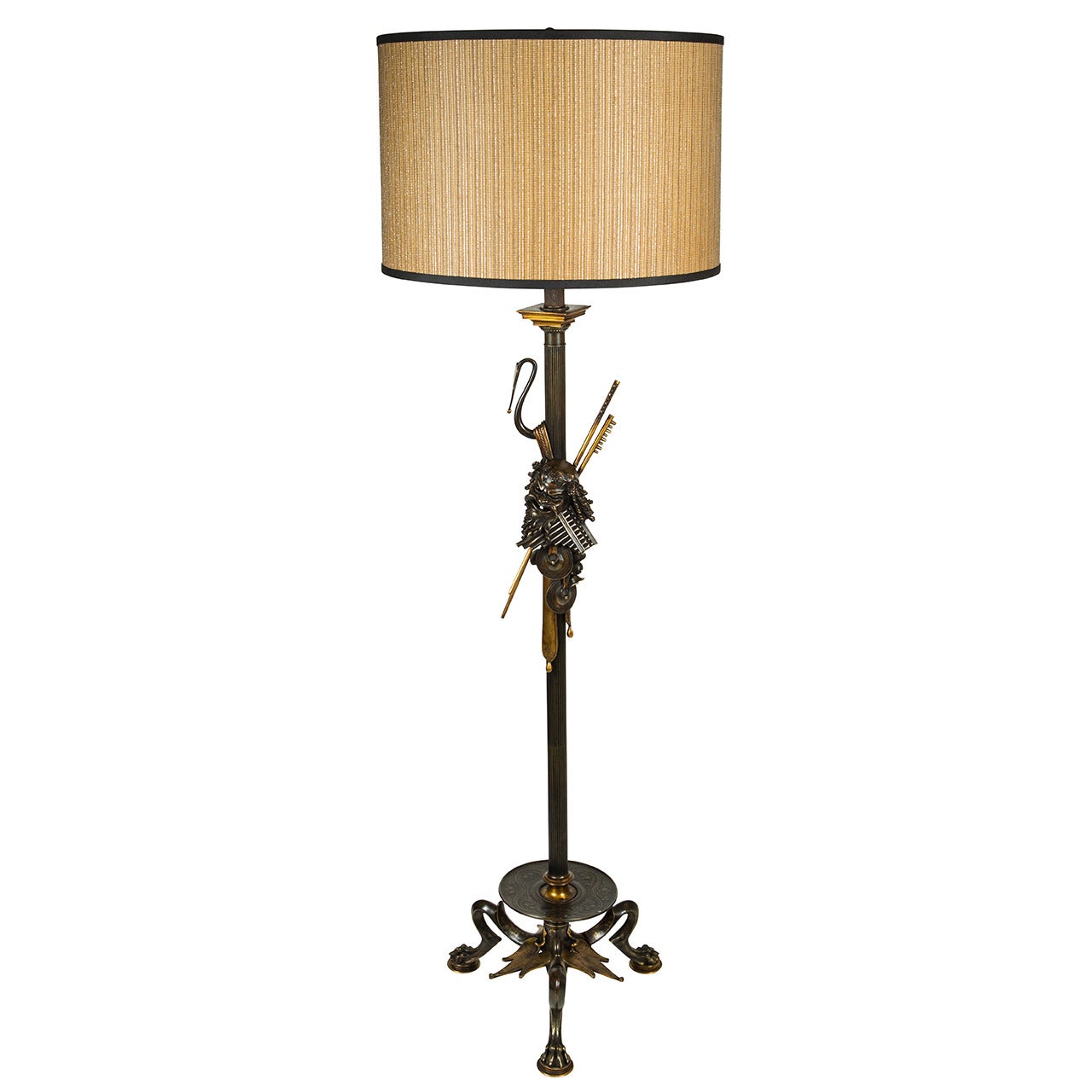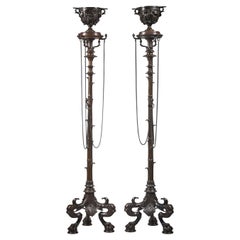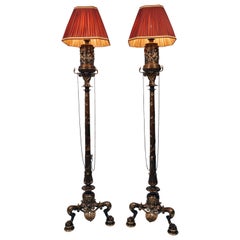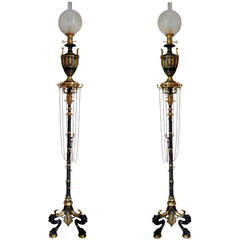
F. Barbedienne Pair of French Neo-Pompeian Bronze Floor Lamps, circa 1855
View Similar Items
1 of 5
F. Barbedienne Pair of French Neo-Pompeian Bronze Floor Lamps, circa 1855
About the Item
- Creator:
- Dimensions:Height: 79.53 in (202 cm)Diameter: 13.78 in (35 cm)
- Sold As:Set of 2
- Style:Neoclassical Revival (In the Style Of)
- Materials and Techniques:
- Place of Origin:
- Period:
- Date of Manufacture:circa 1855
- Condition:
- Seller Location:Paris, FR
- Reference Number:Seller: ref. 0805/121stDibs: LU104781182258
You May Also Like
- Pair of "Bamboo" Stands attr. to H. Cahieux & F. Barbedienne France, circa 1855By Henry Cahieux and Ferdinand BarbedienneLocated in PARIS, FRA similar model presented at the 1855 Paris Universal Exhibition Total height : 154 cm (60 5/8 in.) ; Width : 33 x 33 cm (13 x 13 in.) Cup : height 17 cm (6 ¾ in.) Beautiful pair of bronze stands also named Bamboo candelabra. Each rests on three claw feet adorned with lion heads and separated with palms. A bamboo shaped shaft arises from this tripod and is topped with three buds supporting a circular red griotte marble top on which stands a cup in the Ancient style decorated with ivy. The sobriety of the decoration enhances the quality of the bronze cast and the patina shades. The small chains falling from the top animates this work of a sleek design. The model : The design of these stands, inspired from Ancient tripods, is a well-known model in Ferdinand Barbedienne’s production as it was reused many times by the bronze-caster. Designed by the head-decorator Henri Cahieux, this model was edited by the Barbedienne Company as soon as 1855, named Ancient candelabra lamp-holder h. 1m35 and was sold 440 francs. From 1875, these stands were commercialised under the name Bamboo candelabra, tripod, lamp-holder and were offered in three heights : 1m90, 1m70 and 1m35. This model of stand could then be found in all catalogues of the Barbedienne Company. This pair of candelabras allows us to see how F. Barbedienne offered during decades a range of furniture from the designs of his decorator. This type of stand could be seen in different interior decorations of the Second Empire A model similar to ours was presented by the Barbedienne Company at the 1855 Universal Exhibition. For this occasion Empress Eugénie bought it for her toilet at Saint-Cloud Castle. A watercolor by Fortuné de Fournier made in 1860 shows them, set on both sides of a cheval mirror made by the Fourdinois Company. (see photo attached) This model pleased the Empress so much that she ordered two other pairs in 1858 for her boudoirs at Compiègne and Fontainebleau Palaces. Otherwise similar stands took place in the Pompeiian house built in 1856 by the architect Alfred Normand (1822-1909) for Prince Napoléon. Several pictures and engravings of this house show us these candelabras used...Category
Antique 1850s French Greek Revival Floor Lamps
MaterialsGriotte Marble, Bronze
- Pair of Neo-Greek Bronze Floor Lamps by F. Barbedienne, France, circa 1860By Ferdinand BarbedienneLocated in PARIS, FRHeight without/with lampshade : 168/185 cm (66,1 / 72,8 in.) ; Base : 43 x 43 cm (16,9 x 16,9 in.) Beautiful pair of neo-Greek floor lamps in bronze with double patina, composed of cylindrical lamps, decorated on the body with a rotating frieze representing women dressed in the Antique style weaving and spinning, surmounted by lampshades with cut sides in red pleated silk with golden braid. They are placed on pedestals from which hang thin chains attached to the slender shaft decorated with stylized leaves and flowers, resting on a tripod base decorated with large palmettes and ending in lion’s paws. The stylistic repertoire used here, composed in particular of palmettes, masks, and nymphs, evokes Greek Antiquity, as does the reuse of forms of furniture and objects such as tripods and antique vases. The rediscovery in the 18th century of the archaeological remains of Pompeii and Herculaneum allowed artists of all disciplines to draw inspiration from Antiquity while reinterpreting it. This trend did not fade and, in the 19th century, many personalities fitted out their interiors with neo-Greek furniture, as was the case for the Maison Pompéienne built in 1856 by the architect Alfred Normand (1822-1909) for Prince Napoleon, or Empress Eugénie who bought from the Maison Barbedienne pedestals inspired by antique tripods. Related work : Pedestal model presented by Maison Barbedienne at the Universal Exhibition in Paris in 1855. On this occasion, Empress Eugénie bought it for her bathroom in the Château de Saint-Cloud. This model pleased the Empress so much that she ordered two other pairs in 1858 for her boudoir in the palaces of Compiègne and Fontainebleau. (see photo attached) Photo showing a floor lamp similar to ours in Empress Eugénie’s bedroom in the Château de Compiègne (Oise), in Architecture intérieure et Décoration en France des...Category
Antique 1860s French Greek Revival Floor Lamps
MaterialsBronze
- An Exquisite pair of bronze lamp stands from the 1855 Paris exhibition.By Ferdinand Barbedienne, Henry Cahieux and Ferdinand BarbedienneLocated in London, GBManufactured in France by the renowned Ferdinand Barbedienne and designed by Henry Cahieux specifically for the iconic 1855 Paris Exposition Universelle. The stands with deep brown p...Category
Antique Mid-19th Century French Floor Lamps
MaterialsBronze
- Pair of Neo-Greek Floor Lamps Attributed to G. Servant, France, Circa 1870By Georges Emile Henri ServantLocated in PARIS, FRRare pair of Greek style floor lamps made in patinated bronze attributed to G. Servant, each surmounted of a frosted glass globe engraved of stars and a Greek motif frieze. The body of the vase, decorated with Greek style patterns such as palmets, Greek motif frieze and water leaves, stands on a shaft decorated with deer heads. Fine chains are connected to a delicate butterfly. The set is based on tripod legs with lion claw feet alternating large palmets. Height : 183 cm (72 in.) ; 213 cm (83 3/4 in.) with glass shades ; Diameter : 43 cm (19 2/3in.) Georges Emile Henri Servant (1828-c.1890), who took over his father in 1855 at their foundry, rue Vieille-du-Temple, in Paris, specialized in the production of neo-Egyptian style clocks, very popular in France since 1860’s, and also the making of Greek style decorative objects. He drew considerable attention to the high quality of his bronzes at the 1855 Paris Universal Exhibition and then at the 1862 London Exhibition. At this time Servant exported up to 40% of his production, principally to the United States, where for instance, his clocks were sold with great success by Louis Tiffany Inc. or Hamann & Roche of New York. But his success came really at the 1867 Paris Universal Exhibition, where he was awarded a gold medal for his neo-Greek and Egyptian works (Les Merveilles...Category
Antique 1860s French Greek Revival Floor Lamps
MaterialsBronze
- Pair of Silvered Bronze Large Antique Floor Lamps, Attributed to BarbedienneBy Ferdinand BarbedienneLocated in London, GBThese beautiful antique French floor lamps are cast from delicate silvered bronze, and are decorated in the refined neoclassical style. The p...Category
Antique 19th Century French Neoclassical Floor Lamps
MaterialsBronze
- Pair of Neo-Greek Floor Lamps Att. to Lacarrière, Delatour & Cie, France, C 1860By Lacarrière, Delatour and Co.Located in PARIS, FRMeasures : Total Height : 188,5 cm (74,2 in.) ; Base : 45 x 45 cm (17,7 x 17,7 in.) Pedestal height : 136 cm (53,5 in.) Lamp height : 52 cm (20,4 in.) Beautiful pair of neo-Greek fl...Category
Antique 1860s French Greek Revival Floor Lamps
MaterialsGriotte Marble, Bronze
Recently Viewed
View AllMore Ways To Browse
Laurel Floor Lamp
Laurel Lamp Floor Lamp
Laurel Lighting Floor Lamp
Antique Picture Lamp
Laurel Lamp Co
Antique Chandelier Glass Globes
Antique Lamp Globes
Bamboo Tripod
Tripod Industrial Floor Lamp
19th Century Industrial Lighting
Floor Lamp By Laurel
Pair Of Gilt Floor Lamps
Pair Of 19th Century Floor Lamps
Antique French Boudoir
Boudoir Lamps
Boudoir Lamp
19th Century French Small Chandelier
Large Industrial Clock

